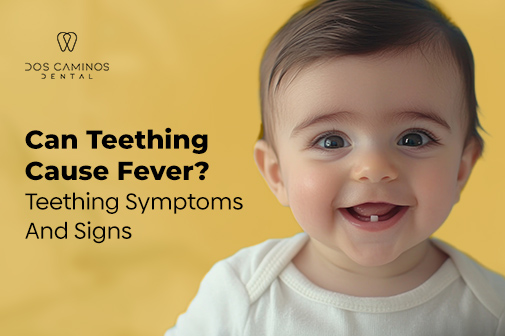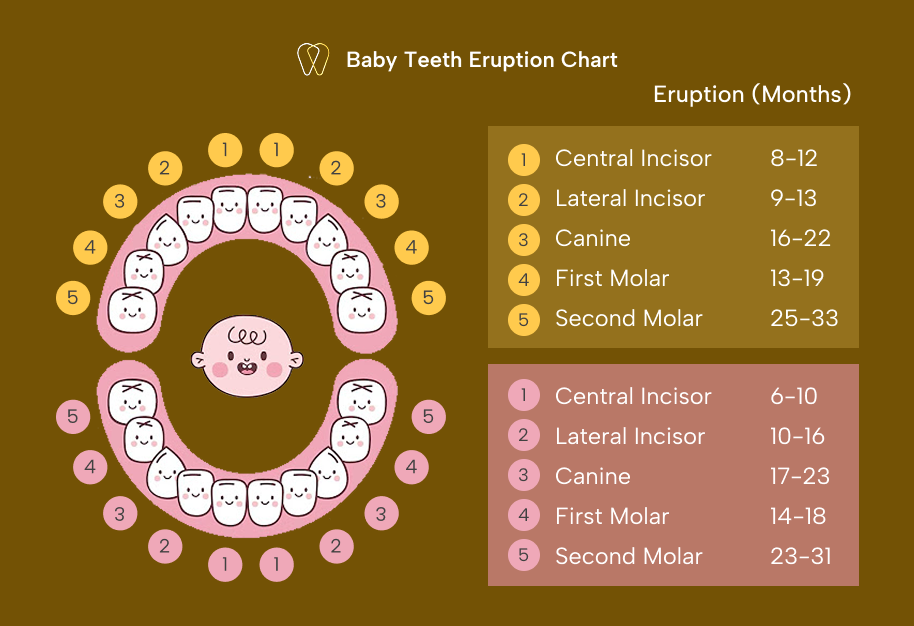
You know your baby is growing up when that adorable gummy smile has tiny white teeth peeking through. This is what we usually call teething.
But this phase in your baby’s development may be accompanied by fussiness, increased drooling, or a loss of appetite. While these symptoms are quite common, one frequently debated sign is fever. Many parents notice a temperature rise during teething and assume the two are connected, but that may not necessarily be true.
In this blog, we’ll walk you through what teething really is, how to spot the signs, bust a few myths, and share practical tips to help your baby (and you) through it.
What Is Teething, and When Does It Start?
When your baby’s teeth start to emerge through the gums, that is called teething. It marks an important development milestone that hints your child is growing up and getting ready for new stages of eating and speech development. No sooner will you hear those cute little mehs and huhs change to one-word sentences.
The teething process typically starts at around 6 months, although it varies widely from one baby to another. Some babies can begin teething as early as 3 months old, while others may start much later. Some babies may not get their first tooth until they are closer to 12 months. It is completely natural, nothing to get competitive about!
The first teeth to show up there whitey heads are usually the lower central incisors—the two bottom front teeth. Then the upper central incisors follow them, mostly.
By the time your child is around 3 years old, they will likely have a complete set of 20 primary teeth, also known as baby or milk teeth. These milk teeth will eventually fall off when your child gets older. However, they play a role in your child’s development. They aid with chewing, speech, and holding space in the jaw for the future permanent teeth.

Although the process is natural, it can be uncomfortable for babies as the teeth push through the sensitive gum tissue. That’s why it’s common to notice various symptoms.
Common Teething Symptoms and Signs
While teething affects every baby differently, here are the most common symptoms:

Do Babies Get Fevers When Teething?
One of the most debated teething topics is whether it causes a fever.
Let’s set the record straight—teething does NOT cause a high fever.
This common misconception about teething and fever stems from the fact that some babies may feel a little warmer than usual during teething. This slight increase in temperature can happen due to mild inflammation in the gums as teeth push through. However, this is usually very subtle and does not qualify as an actual fever.
Any fever above 100.4°F (38°C) should not be attributed to teething, it can be something else. If your baby has a high fever, diarrhea, rash, or other signs of illness, consult your pediatrician—it could be something unrelated, such as a viral or bacterial infection.
It’s always better to be cautious, especially when your little one is uncomfortable or unwell.
Busting Common Teething Myths
| Myth | Fact |
|---|---|
| Babies get a fever from teething. | Teething may cause slight warmth, but not a high fever. |
| Diarrhea is a normal teething symptom. | Diarrhea is not linked to teething. See a doctor. |
| Babies don’t feel pain while teething. | Teething can be sore and uncomfortable. |
| Teething tablets and gels are safe. | Some contain harmful ingredients. Always ask your doctor. |
| More drooling means a tooth is coming tomorrow. | Drooling can start weeks before the tooth appears. |
| Rashes are caused by teething. | Rashes may be from drool irritation, not teething itself. |
| All babies start teething at 6 months. | Timing varies—some start at 3 months, others much later. |
When to Be Concerned: Recognizing Signs of Illness
While teething itself is harmless, watch for these red flags that could indicate illness:

If you notice any of these, don’t hesitate to call your child’s doctor.
Soothing Your Teething Baby: Practical Tips
Teething can be uncomfortable, but the good news is, there are simple ways to ease your baby’s discomfort. Here are some safe and effective tips:
| Massage the gums | Gently rub your baby’s gums using a clean finger or soft, damp gauze. The pressure helps relieve the soreness and distracts them from the pain. |
| Use chilled (not frozen) teething toys | Give your baby a cold teething ring or metal spoon. Cool temperatures can ease gum discomfort—but don’t freeze teething toys, as that can be too harsh for your baby’s gums. |
| Try a clean, wet washcloth | Soak a clean cloth in cold water, wring it out, and let your baby chew on it. It’s soft on the gums and helps reduce swelling. |
| Keep them distracted | Sometimes, a little fun is the best remedy! Play with your baby, cuddle them, or go for a short walk. Distraction helps take their mind off the discomfort. |
| Wipe drool frequently | Drooling is a major part of teething. Keep your baby’s face dry by gently wiping it with a soft cloth throughout the day. This helps prevent rashes and skin irritation around the mouth and chin. |
| Extra comfort at bedtime | Teething pain can interrupt sleep. Stick to a calming bedtime routine—warm baths, lullabies, or gentle rocking can help your baby relax. |
Maintaining Oral Hygiene During Teething
As they say, teach them young! You can start building healthy oral care habits from the early years.
- The gums may have bacteria. So, dampen a clean cloth and use it to gently wipe your baby’s gums every day.
- Once that first tooth pops through, switch to a soft-bristled toothbrush and use a smear (about the size of a grain of rice) of fluoride toothpaste.
- Avoid letting your baby fall asleep with a bottle in their mouth.
- This can cause early tooth decay, also referred to as “baby bottle decay.”
- And most importantly, don’t forget to book their first dental check-up by their first birthday!
Final Words
The arrival of baby teeth is often a joyous part of your child’s early growth. While it can be uncomfortable, it’s rarely a cause for serious concern. By arming yourself with the right knowledge, understanding the signs, and knowing how to soothe your little one, you’ll be able to manage this phase comfortably.
Remember: if something doesn’t feel right, always trust your gut. When in doubt, just reach out.
FAQs
1. Can a Baby Get 103°F Fever From Teething?
No. A 103°F fever is too high to be caused by teething. It’s likely due to an infection—see a doctor.
2. Does Teething Cause Fever?
Teething may cause a slight rise in temperature. But not an actual fever (100.4°F or higher).
3. What Is the Teething Fever Range?
Teething may cause mild warmth, but not above 99–100°F. Anything higher isn’t due to teething.
4. Why Does Teething Cause Fever?
It doesn’t. Gum inflammation can make your baby feel slightly warm, but it’s not a true fever.
 2438 N Ponderosa Dr, C-111, Camarillo, CA 93010
2438 N Ponderosa Dr, C-111, Camarillo, CA 93010





